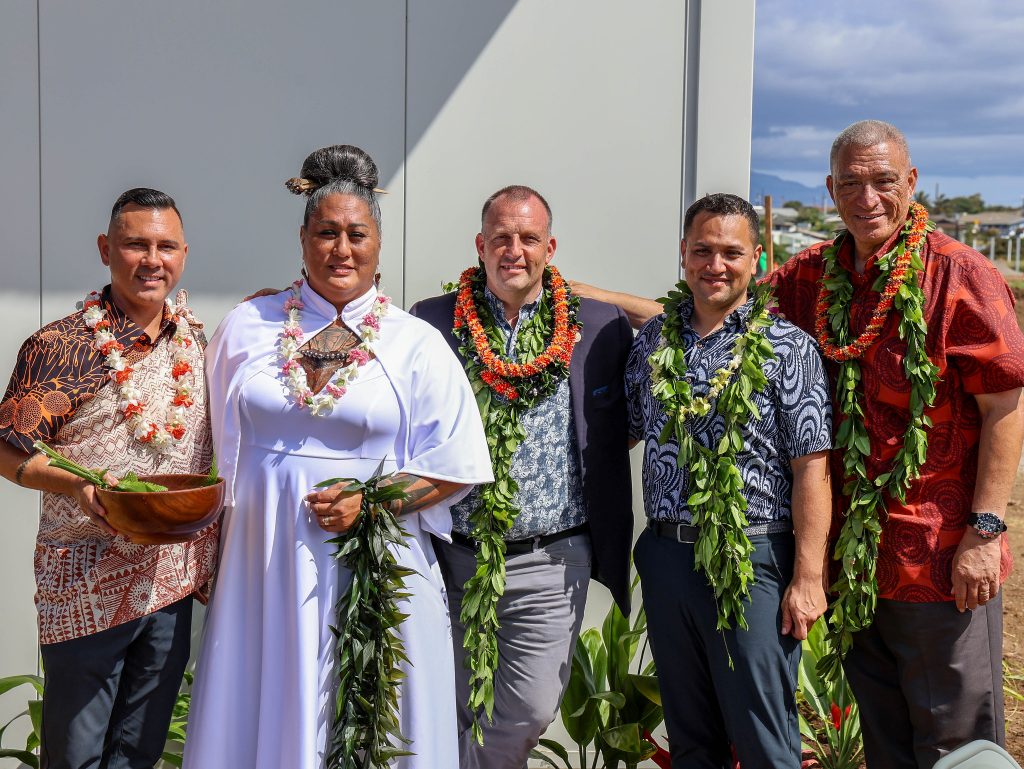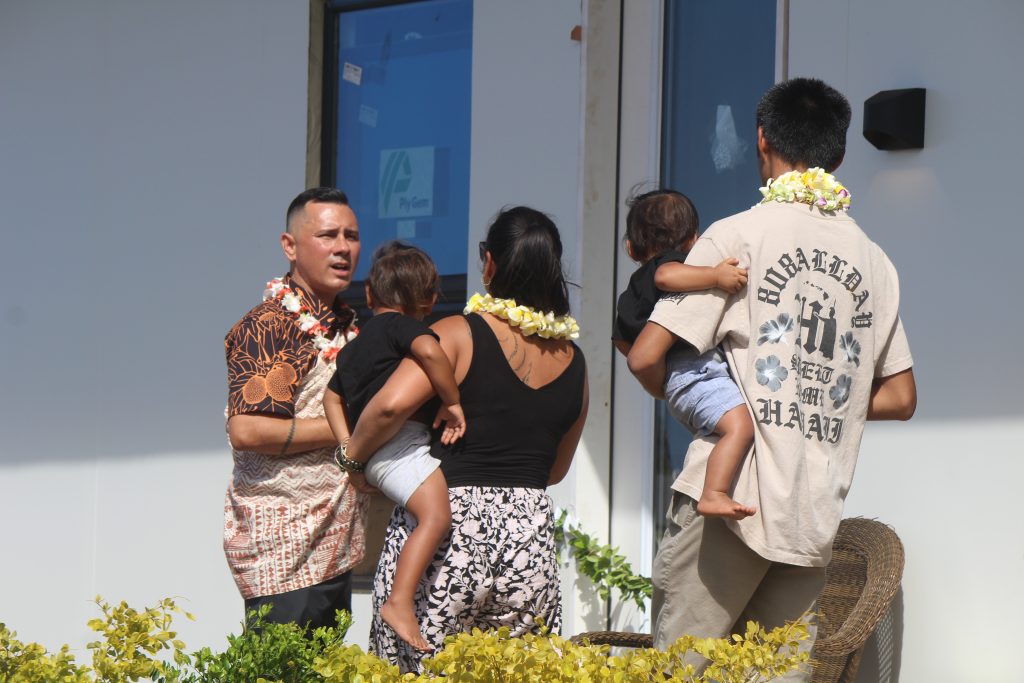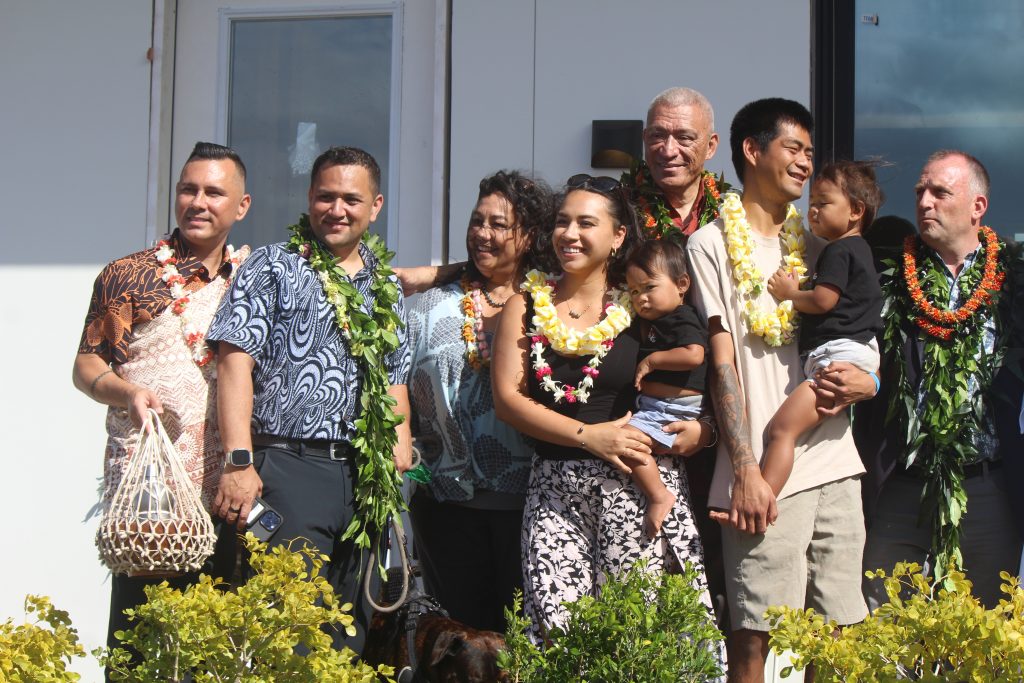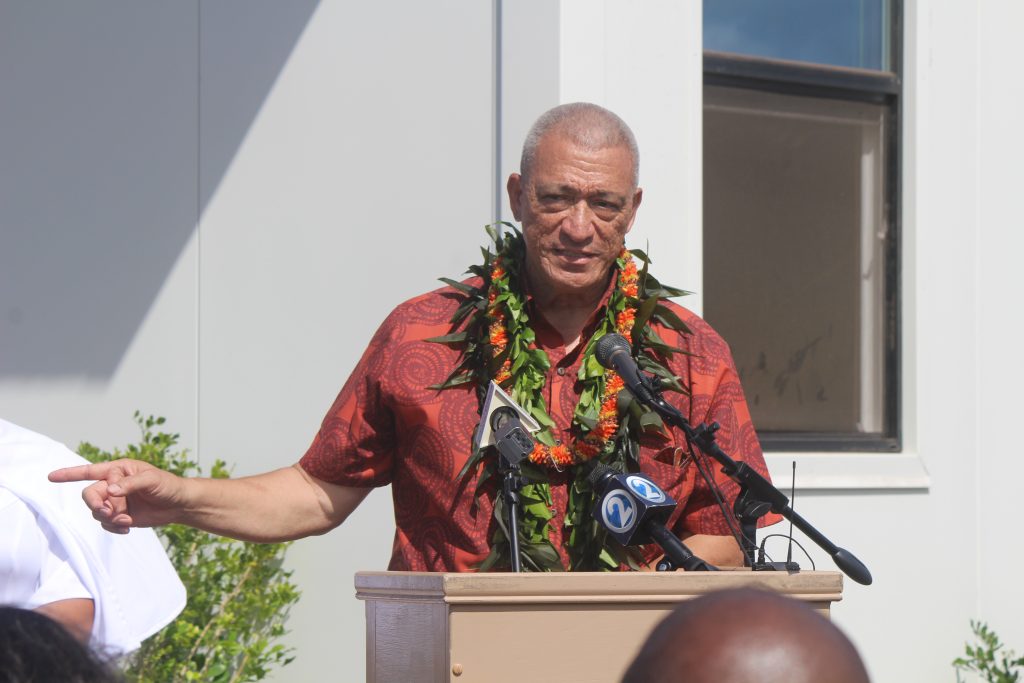Ke Ao Maluhia at Maui Lani welcomes first family of residents with keys; Marks milestone for wildfire survivors

A family of four from Lahaina received keys on Tuesday to the very first home at the new Ke Ao Maluhia development at Maui Lani in Kahului. The development will serve as interim housing for Maui wildfire survivors.
Located near the intersection of Pu‘umakani and Kea St., the project is a collaborative effort between the state of Hawai‘i, Maui County, the Hawaiʻi Community Foundation, the Council for Native Hawaiian Advancement, FEMA, and the American Red Cross. The first phase, set to be completed in June, includes 34 homes. An additional 16 homes will be completed in July, for a total of 50 units.
The Fraser family—including mom, dad and two keiki (1 and 3 years old)—moved nine times over the last nine months following the loss of their home in the Lahaina wildfire. For mom Josephine, today was a long-time coming. “I’m super excited. I can’t wait till we can move in… We’re just very grateful for all of this,” she said.
“There was a lot of times where we had to think about whether or not we were going to leave the island and not be home anymore, because we didn’t know what was going to happen. We didn’t know when we had to leave the hotels,” she said, noting in one move, they were given just 24 hours notice.
“The longest that we’ve stayed at one place was maybe a month. So having to explain to my 3-year-old, who is very, very smart for his age: ‘Okay, we’re not going to be here anymore. This is going to be our new place,'” Josephine said was difficult.
She said as the family looks ahead, the plan is to eventually return to Lahaina when the time is right. “You know, that’s always going to be our home,” she said.
Many government and community leaders were on hand to witness the milestone event, including Gov. Josh Green, M.D., Maui County Mayor Richard Bissen, Hawai‘i Community Foundation Senior Vice President of Maui Recovery Lauren Nahme, and Kūhiō Lewis, CEO of the Council for Native Hawaiian Advancement.
Gov. Green called it a day of progress, most importantly, for the survivors of the tragic Maui wildfires. “Building affordable housing has always been a priority for me, but since Aug. 8 and for our Maui residents in particular, its importance has become even more critical. Presenting actual keys to an ‘ohana today brings hope and healing beyond words,” he said.
The state peaked with 3,017 households or about 8,000 displaced wildfire survivors from Maui in hotels.
“We’ve been able to get 76.5% of the people that were in hotels into long term rentals or transitional housing. So we’re about three quarters of the way there,” said Green.
CNHA CEO Kūhiō Lewis said the buildout at Ke Ao Maluhia will happen at a rate of two units per week, and then it will speed up to four per week, concluding in July.
With the addition of 50 units at Ke Ao Maluhia, 450 transitional houses being built at Ka Laʻi Ola in Lahaina, and 175 units at Haggai in Kīhei, the governor said there will be an acceleration of the last families that need to get into stable, long-term housing. Officials say they have been placing about 100 individuals per week in housing, and anticipate that number will accelerate as these projects are brought online.
“We hope by really by July 1, that there’s simply no one that needs to be in a hotel unless they have a significant need or there’s some reason that they choose,” said Green.
“One of the reasons I think it was so extraordinary to see the Fraser family is because they tell the story of what happened to many people, which was there were options; but in recoveries like this, after a disaster, there’s just so many challenges. And they moved many times.. and they were so strong to get through that. That’s why we’re excited in the next couple days when they get to start sleeping in the same bedroom for good,” said Green.

Maui Mayor Richard Bissen called the project another example of the commitment to support the needs of displaced survivors. He said it’s evidence that “through collaborative and innovative partnerships, we can do great things.” He continued, “We are making progress, and we will continue to work with our state, federal and private partners in addressing Maui County’s recovery efforts.”
Mayor Bissen gave special thanks to the Homeowners Association, which allowed more than one dwelling on each lot and a five year lease for the project. “They’re allowing us five years. I think it’s maybe a little too soon to decide if it’s going to extend beyond that, because we’re hoping it doesn’t take us that long to repopulate Lahaina, and get our folks back there,” said Mayor Bissen.
Kumu Cody Pueo Pata, who conducted a blessing of the structure and is credited with selecting the name of the project, explained: “The name harkens to the ʻōlelo noʻeau (traditional saying) for this region—Wailuku malu i ke ao, Wailuku sheltered by the clouds. Ke Ao Maluhia means the clouds that provide shelter, but also ‘ao’ means realm. It means the protected realm. That this is a place of refuge,” he said.
“This is the ahupuaʻa of Wailuku… Just below this ridge is… where the large battle between Kalaniopuʻu’s forces and Kahekili’s forces took place. After that battle, Kalaniopuʻu’s men—they received permission to take refuge in the moku of Lahaina in the ahupuaʻa of Olowalu,” Pata explained.
“So after the devastation here in Wailuku, they received care in Olowalu… resuscitation until they were able to get back on their feet and make their journey home. But now, after the devastation in the moku of Lahaina, Wailuku is now providing refuge for these families. And so it’s a very beautiful thing and in my opinion,” said Pata.

“All of us at HCF mahalo the generosity of more than 250,000 donors from 76 countries around the world who leaned in to support Maui and made Ke Ao Maluhia possible,” said HCF President and CEO Micah Kāne in the announcement. “We will continue to foster collaborative partnerships to deliver on the needs of survivors now and in the long-term.”
The project’s cost is just under $9 million and is being developed and managed by CNHA on land owned by Maui County. Wrap-around services, including financial literacy, will be provided by CNHA’s Kākoʻo Maui Relief & Aid Services Center, according to the announcement.
“Today marks the strength of partnerships and is a testament to what can be achieved when government, the private sector, nonprofit organizations, and the community work together,” said Lewis of CNHA. “Delivering the first home at Ke Ao Maluhia through the Maui Interim Housing Plan is a significant milestone for families and a clear indication of our collective commitment to addressing Maui’s housing crisis.”

The modular homes are each just under 600 square feet with two bedrooms. To apply, residents must be verified as impacted by the Maui wildfires. There is no income limit. Monthly rent is set at $2,500 and will include water, sewer, and trash collection. Minimum occupancy per unit is two people, with maximum occupancy set at five people per unit. Dogs and cats are permitted. For more information and details on how to apply, please visit www.helpingmaui.org.
Labor support for the project is being provided by the Hawai‘i Regional Council of Carpenters with furniture donated by Convoy for Hope.
Officially announced in January, the Maui Interim Housing Plan outlines a phased approach to delivering housing, prioritizing options that produce permanent housing, efficient use of funds, and readiness for move-in by survivors. The plan includes various strategies such as residents returning to original unharmed residences, the Host Housing Support Program, direct leasing, short-term rental transitions to long-term rentals, and new permanent developments.























